Thiophene-Based Covalent Triazine Frameworks as Visible-Light-Driven Heterogeneous Photocatalysts for the Oxidative Coupling of Amines
Abstract
1. Introduction
2. Results and Discussion
2.1. Synthesis and Characterization
2.2. Photocatalytic Coupling of Amines
3. Experimental Section
3.1. Reagents and Chemicals
3.2. Synthesis of TP-CTF
3.3. Catalyst Characterization
3.4. Photocatalytic Experiments
3.4.1. General Procedure for the Homo-Coupling of Benzylamine
3.4.2. General Procedure for the Cross-Coupling of Amines
4. Conclusions
Supplementary Materials
Author Contributions
Funding
Institutional Review Board Statement
Informed Consent Statement
Data Availability Statement
Conflicts of Interest
References
- Krishnaraj, C.; Jena, H.S.; Leus, K.; Van Der Voort, P. Covalent triazine frameworks-a sustainable perspective. Green Chem. 2020, 22, 1038–1071. [Google Scholar] [CrossRef]
- Ma, S.; Li, Z.; Jia, J.; Zhang, Z.; Xia, H.; Li, H.; Chen, X.; Xu, Y.; Liu, X. Amide-linked covalent organic frameworks as efficient heterogeneous photocatalysts in water. Chin. J. Catal. 2021, 42, 2010–2019. [Google Scholar] [CrossRef]
- Hao, Q.; Tao, Y.; Ding, X.; Yang, Y.; Feng, J.; Wang, R.-L.; Chen, X.-M.; Chen, G.-L.; Li, X.; OuYang, H.; et al. Porous organic polymers: A progress report in China. Sci. China Chem. 2023, 66, 620–682. [Google Scholar] [CrossRef]
- Chongdar, S.; Bhattacharjee, S.; Bhanja, P.; Bhaumik, A. Porous organic–inorganic hybrid materials for catalysis, energy and environmental applications. Chem. Commun. 2022, 58, 3429–3460. [Google Scholar] [CrossRef] [PubMed]
- Mukherjee, G.; Thote, J.; Aiyappa, H.B.; Kandambeth, S.; Banerjee, S.; Vanka, K.; Banerjee, R. A porous porphyrin organic polymer (PPOP) for visible light triggered hydrogen production. Chem. Commun. 2017, 53, 4461–4464. [Google Scholar] [CrossRef] [PubMed]
- Zhang, T.; Xing, G.; Chen, W.; Chen, L. Porous organic polymers: A promising platform for efficient photocatalysis. Mater. Chem. Front. 2020, 4, 332–353. [Google Scholar] [CrossRef]
- Ji, G.; Zhao, Y.; Liu, Z. Green Chemical Engineering Design of porous organic polymer catalysts for transformation of carbon dioxide. Green Chem. Eng. 2022, 3, 96–110. [Google Scholar] [CrossRef]
- Chen, M.; Zhang, J.; Liu, C.; Li, H.; Yang, H.; Feng, Y.; Zhang, B. Construction of Pyridine-Based Chiral Ionic Covalent Organic Frameworks as a Heterogeneous Catalyst for Promoting Asymmetric Henry Reactions. Org. Lett. 2021, 23, 1748–1752. [Google Scholar] [CrossRef]
- Guo, J.; Jiang, D. Covalent Organic Frameworks for Heterogeneous Catalysis: Principle, Current Status, and Challenges. ACS Cent. Sci. 2020, 6, 869–879. [Google Scholar] [CrossRef]
- Zhang, J.; Cao, Y.; Liu, W.; Cao, T.; Qian, J.; Wang, J.; Yao, X.; Iqbal, A.; Qin, W. Structural Engineering of Covalent Organic Frameworks Comprising Two Electron Acceptors Improves Photocatalytic Performance. ChemSusChem 2022, 15, e202101510. [Google Scholar] [CrossRef]
- Li, Z.; Zhi, Y.; Shao, P.; Xia, H.; Li, G.; Femg, X.; Chen, X.; Shi, Z.; Liu, X. Covalent organic framework as an efficient, metal-free, heterogeneous photocatalyst for organic transformations under visible light. Appl. Catal. B 2019, 245, 334–342. [Google Scholar] [CrossRef]
- Li, Z.; Wang, J.; Ma, S.; Zhang, Z.; Zhi, Y.; Zhang, F.; Xia, H.; Henkelman, G.; Liu, X. 2D covalent organic frameworks for photosynthesis of α-trifluoromethylated ketones from aromatic alkenes. Appl. Catal. B 2022, 310, 121335. [Google Scholar] [CrossRef]
- Yang, Y.; Niu, H.; Xu, L.; Zhang, H.; Cai, Y. Triazine functionalized fully conjugated covalent organic framework for efficient photocatalysis. Appl. Catal. B 2020, 269, 118799. [Google Scholar] [CrossRef]
- Saputra, E.; Nugraha, M.W.; Prawiranegara, B.A.; Sambudi, N.S.; Oh, W.; Peng, W.; Sugesti, H.; Utama, P.S. Synergistic copper-modified covalent triazine framework for visible-light-driven photocatalytic degradation of organic pollutant. Environ. Nanotechnol. Monit. Manag. 2023, 19, 100774. [Google Scholar] [CrossRef]
- Qian, Z.; Wang, Z.J.; Zhang, K.A.I. Covalent Triazine Frameworks as Emerging Heterogeneous Photocatalysts. Chem. Mater. 2021, 33, 1909–1926. [Google Scholar] [CrossRef]
- Liu, M.; Guo, L.; Jin, S.; Tan, B. Covalent triazine frameworks: Synthesis and applications. J. Mater. Chem. A Mater. 2019, 7, 5153–5172. [Google Scholar] [CrossRef]
- Bügel, S.; Hoang, Q.-D.; Spieß, A.; Sun, Y.; Xing, S.; Janiak, C. Biphenyl-Based Covalent Triazine Framework/Matrimid ® Mixed-Matrix Membranes for CO2/CH4 Separation. Membranes 2021, 11, 795. [Google Scholar] [CrossRef] [PubMed]
- Dey, S.; Bügel, S.; Sorribas, S.; Nuhnen, A. Synthesis and Characterization of Covalent Triazine Framework CTF-1 @ Polysulfone Mixed Matrix Membranes and Their Gas Separation Studies. Front. Chem. 2019, 7, 693. [Google Scholar] [CrossRef]
- Bhadra, M.; Kandambeth, S.; Sahoo, M.K.; Addicoat, M.; Balaraman, E.; Banerjee, R. Triazine Functionalized Porous Covalent Organic Framework for Photo-organocatalytic E- Z Isomerization of Olefins. J. Am. Chem. Soc. 2019, 141, 6152–6156. [Google Scholar] [CrossRef]
- Sun, R.; Tan, B. Covalent Triazine Frameworks(CTFs) for Photocatalytic Applications. Chem. Res. Chin. Univ. 2022, 38, 310–324. [Google Scholar] [CrossRef]
- Abednatanzi, S.; Derakhshandeh, P.G.; Dalapati, S.; Veerapandian, S.K.P.; Froissart, A.C.; Epping, J.D.; Morent, R.; De Geyter, N.; Van Der Voort, P. Metal-Free Chemoselective Reduction of Nitroarenes Catalyzed by Covalent Triazine Frameworks: The Role of Embedded Heteroatoms. ACS Appl. Mater. Interfaces 2022, 14, 15287–15297. [Google Scholar] [CrossRef] [PubMed]
- Yang, Q.; Luo, M.; Liu, K.; Cao, H.; Yan, H. Covalent organic frameworks for photocatalytic applications. Appl. Catal. B 2020, 276, 119174. [Google Scholar] [CrossRef]
- Caballero, R.; Cohen, B.; Gutiérrez, M. Thiophene-based covalent organic frameworks: Synthesis, photophysics and light-driven applications. Molecules 2021, 26, 7666. [Google Scholar] [CrossRef] [PubMed]
- Liu, M.; Yao, C.; Liu, C.; Xu, Y. Thiophene-based porous organic networks for volatile iodine capture and effectively detection of mercury ion. Sci. Rep. 2018, 8, 14071. [Google Scholar] [CrossRef]
- An, W.K.; Zhen, S.J.; Du, Y.N.; Ding, S.Y.; Li, Z.J.; Jiang, S.; Qin, Y.; Liu, X.; Wei, P.F.; Cao, Z.Q.; et al. Thiophene-embedded conjugated microporous polymers for photocatalysis. Catal. Sci. Technol. 2020, 10, 5171–5180. [Google Scholar] [CrossRef]
- Meng, L.; Fujikawa, T.; Kuwayama, M.; Segawa, Y.; Itami, K. Thiophene-Fused π-Systems from Diarylacetylenes and Elemental Sulfur. J. Am. Chem. Soc. 2016, 138, 10351–10355. [Google Scholar] [CrossRef]
- Cui, Y.; Du, J.; Liu, Y.; Yu, Y.; Wang, S.; Pang, H.; Liang, Z.; Yu, J. Design and synthesis of a multifunctional porous N-rich polymer containing s-triazine and Tröger’s base for CO2 adsorption, catalysis and sensing. Polym. Chem. 2018, 9, 2643–2649. [Google Scholar] [CrossRef]
- López-Magano, A.; Jiménez-Almarza, A.; Alemán, J.; Mas-Ballesté, R. Metal–Organic Frameworks (MOFs) and Covalent Organic Frameworks (COFs) Applied to Photocatalytic Organic Transformations. Catalysts 2020, 10, 720. [Google Scholar] [CrossRef]
- Sönmez, T.; Belthle, K.S.; Iemhoff, A.; Uecker, J.; Artz, J.; Bisswanger, T.; Stampfer, C.; Hamzah, H.H.; Nicolae, S.A.; Titirici, M.M.; et al. Metal free-covalent triazine frameworks as oxygen reduction reaction catalysts—Structure-electrochemical activity relationship. Catal. Sci. Technol. 2021, 11, 6191–6204. [Google Scholar] [CrossRef]
- Puthiaraj, P.; Lee, Y.R.; Zhang, S.; Ahn, W.S. Triazine-based covalent organic polymers: Design, synthesis and applications in heterogeneous catalysis. J. Mater. Chem. A Mater. 2016, 4, 16288–16311. [Google Scholar] [CrossRef]
- Tahir, N.; Krishnaraj, C.; Leus, K.; Van Der Voort, P. Development of covalent triazine frameworks as heterogeneous catalytic supports. Polymers 2019, 11, 1326. [Google Scholar] [CrossRef] [PubMed]
- Yadav, D.; Awasthi, S.K. An unsymmetrical covalent organic polymer for catalytic amide synthesis. Dalton Trans. 2020, 49, 179–186. [Google Scholar] [CrossRef] [PubMed]
- Zhi, Y.; Li, Z.; Feng, X.; Xia, H.; Zhang, Y.; Shi, Z.; Mu, Y.; Liu, X. Covalent organic frameworks as metal-free heterogeneous photocatalysts for organic transformations. J. Mater. Chem. A 2017, 5, 22933–22938. [Google Scholar] [CrossRef]
- Ahmed, I.; Yu, K.; Puthiaraj, P.; Ahn, W.S. Metal-free oxidative desulfurization over a microporous triazine polymer catalyst under ambient conditions. Fuel Process. Technol. 2020, 207, 106469. [Google Scholar] [CrossRef]
- Fuerte-Díez, B.; Valverde-González, A.; Pintado-Sierra, M.; Díaz, U.; Sánchex, F.; Maya, E.M.; Iglesias, M. Phenyl Extended Naphthalene-Based Covalent Triazine Frameworks as Versatile Metal-Free Heterogeneous Photocatalysts. Solar RRL 2022, 6, 1–10. [Google Scholar] [CrossRef]
- Abednatanzi, S.; Derakhshandeh, P.G.; Leus, K.; Callens, F.; Schmidt, J.; Savateev, A.; Van Der Voort, P. Metal-free activation of molecular oxygen by covalent triazine frameworks for selective aerobic oxidation. Sci. Adv. 2020, 6, eaaz2310. [Google Scholar] [CrossRef] [PubMed]
- Jiménez-Almarza, A.; López-Magano, A.; Marzo, L.; Cabrera, S.; Mas-Ballesté, R.; Alemán, J. Imine-Based Covalent Organic Frameworks as Photocatalysts for Metal Free Oxidation Processes under Visible Light Conditions. ChemCatChem 2019, 11, 4916–4922. [Google Scholar] [CrossRef]
- Chen, B.; Wang, L.; Dai, W.; Shang, S.; Lv, Y.; Gao, S. Metal-free and solvent-free oxidative coupling of amines to imines with mesoporous carbon from macrocyclic compounds. ACS Catal. 2015, 5, 2788–2794. [Google Scholar] [CrossRef]
- Roeser, J.; Kailasam, K.; Thomas, A. Covalent triazine frameworks as heterogeneous catalysts for the synthesis of cyclic and linear carbonates from carbon dioxide and epoxides. ChemSusChem 2012, 5, 1793–1799. [Google Scholar] [CrossRef]
- Lian, C.; Zhang, C.; Zhao, Y.; Wang, H.; Li, X.; Huang, L. Oxidative coupling of primary amines to imines catalyzed by CoCl2·6H2O. Appl. Organomet. Chem. 2022, 36, 1–10. [Google Scholar] [CrossRef]
- Liu, L.; Zhang, S.; Fu, X.; Yan, C.H. Metal-free aerobic oxidative coupling of amines to imines. Chem. Commun. 2011, 47, 10148–10150. [Google Scholar] [CrossRef] [PubMed]
- Zheng, H.; Shi, S.; Wang, X.; Zhao, L.; Zhu, G.; Liu, M.; Gao, J.; Xu, J. Covalent Triazine Frameworks as Metal Free Catalysts for the Oxidative Coupling of Amines to Imines. ChemistrySelect 2019, 4, 5073–5080. [Google Scholar] [CrossRef]
- Pachfule, P.; Acharjya, A.; Roeser, J.; Sivasankaran, R.P.; Ye, M.-Y.; Brückner, A.; Schmidt, J.; Thomas, A. Donor–acceptor covalent organic frameworks for visible light induced free radical polymerization. Chem. Sci. 2019, 10, 8316–8322. [Google Scholar] [CrossRef] [PubMed]
- Kang, C.; Zhang, Z.; Usadi, A.K.; Calabro, D.C.; Saunders Baugh, L.; Yu, K.; Wang, Y.; Zhao, D. Aggregated Structures of Two-Dimensional Covalent Organic Frameworks. J. Am. Chem. Soc. 2022, 144, 3192–3199. [Google Scholar] [CrossRef]
- Huang, N.; Chen, X.; Krishna, R.; Jiang, D. Two-Dimensional Covalent Organic Frameworks for Carbon Dioxide Capture through Channel-Wall Functionalization. Angew. Chem. Int. Ed. 2015, 54, 2986–2990. [Google Scholar] [CrossRef] [PubMed]
- Jin, E.; Fu, S.; Hanayama, H.; Addicoat, M.A.; Wei, W.; Chen, Q.; Graf, R.; Landfester, K.; Bonn, M.; Zhang, K.A.I.; et al. A Nanographene-Based Two-Dimensional Covalent Organic Framework as a Stable and Efficient Photocatalyst. Angew. Chem. Int. Ed. 2022, 61, e202114059. [Google Scholar] [CrossRef] [PubMed]
- Han, X.H.; Qi, Q.Y.; Zhou, Z.B.; Zhao, X. Designed Synthesis of a Two-Dimensional Covalent Organic Framework with Three-Level Hierarchical Porosity. Chin. J. Chem. 2020, 38, 1676–1680. [Google Scholar] [CrossRef]
- Li, Y.; Ou, Z.; Liang, B.; Yang, J.; Chen, R.; Qi, H.; Kaiser, U.; Hong, W.; Chen, X.; Du, L.; et al. Cellulose nanocrystals as template for improving the crystallinity of two-dimensional covalent organic framework films. Polymers 2021, 13, 1561. [Google Scholar] [CrossRef]
- Peng, Y.; Hu, Z.; Gao, Y.; Yuan, D.; Kang, Z.; Qian, Y.; Yan, N.; Zhao, D. Synthesis of a Sulfonated Two-Dimensional Covalent Organic Framework as an Efficient Solid Acid Catalyst for Biobased Chemical Conversion. ChemSusChem 2015, 8, 3208–3212. [Google Scholar] [CrossRef]
- Wei, H.; Chai, S.; Hu, N.; Yang, Z.; Wei, L.; Wang, L. The microwave-assisted solvothermal synthesis of a crystalline two-dimensional covalent organic framework with high CO2 capacity. Chem. Commun. 2015, 51, 12178–12181. [Google Scholar] [CrossRef]
- Bertrand, G.H.V.; Michaelis, V.K.; Ong, T.C.; Griffin, R.G.; Dincâ, M. Thiophene-based covalent organic frameworks. PNAS 2013, 110, 4923–4928. [Google Scholar] [CrossRef]
- Kuhn, P.; Forget, A.; Su, D.; Thomas, A.; Antonietti, M. From microporous regular frameworks to mesoporous materials with ultrahigh surface area: Dynamic reorganization of porous polymer networks. J. Am. Chem. Soc. 2008, 130, 13333–13337. [Google Scholar] [CrossRef] [PubMed]
- Li, C.; Li, D.; Zhang, W.; Li, H.; Yu, G. Towards High-Performance Resistive Switching Behavior through Embedding a D-A System into 2D Imine-Linked Covalent Organic Frameworks. Angew. Chem. Int. Ed. 2021, 60, 27135–27143. [Google Scholar] [CrossRef] [PubMed]
- Zanatta, A.R. Revisiting the optical bandgap of semiconductors and the proposal of a unified methodology to its determination. Sci. Rep. 2019, 9, 11225. [Google Scholar] [CrossRef]
- Hu, Y.H.; Ruckenstein, E. Applicability of Dubinin-Astakhov equation to CO2 adsorption on single-walled carbon nanotubes. Chem. Phys. Lett. 2006, 425, 306–310. [Google Scholar] [CrossRef]
- Sharma, A.; Malani, A.; Medhekar, N.V.; Babarao, R. CO2 adsorption and separation in covalent organic frameworks with interlayer slipping. CrystEngComm 2017, 19, 6950–6963. [Google Scholar] [CrossRef]
- Vitillo, J.; Presti, D.; Luz, I.; Llabrés i Xamena, F.X.; Bordiga, S. Visible-light driven photocatalytic coupling of benzylamine over titanium-based MIL-125-NH2 metal-organic framework: A mechanistic study. J. Phys. Chem. C 2020, 124, 23707–23715. [Google Scholar] [CrossRef]
- Mohan, A.; Sayah, M.H.; Al Ahmed, A.; Kadri, O.M.E. Triazine based porous organic polymers for reversible capture of iodine and utilization in antibacterial application. Sci. Rep. 2022, 12, 2638. [Google Scholar] [CrossRef] [PubMed]
- Cheng, H.; Wang, T. Covalent Organic Frameworks in Catalytic Organic Synthesis. Adv. Synth.Catal. 2020, 363, 144–193. [Google Scholar] [CrossRef]
- Li, P.; Dong, X.; Zhang, Y.; Lang, X.; Wang, C. An azine-linked 2D porphyrinic covalent organic framework for red light photocatalytic oxidative coupling of amines. Mater. Today Chem. 2022, 25, 100953. [Google Scholar] [CrossRef]
- Hu, X.; Zhan, Z.; Zhang, J.; Hussain, I.; Tan, B. Immobilized covalent triazine frameworks films as effective photocatalysts for hydrogen evolution reaction. Nat. Commun. 2021, 12, 1–9. [Google Scholar] [CrossRef] [PubMed]
- Prakash, K.; Chaudhary, K.; Masram, D.T. Applied Catalysis A, General A new triazine-cored covalent organic polymer for catalytic applications. Appl. Cata.l A Gen. 2020, 593, 117411. [Google Scholar]
- Chan-Thaw, C.E.; Villa, A.; Katekomol, P.; Su, D.; Thomas, A.; Prati, L. Covalent triazine framework as catalytic support for liquid phase reaction. Nano Lett. 2010, 10, 537–541. [Google Scholar] [CrossRef] [PubMed]
- Li, J.; Zhang, L.; Liu, X.; Shang, N.; Gao, S.; Feng, C.; Wang, C.; Wang, Z. Pd nanoparticles supported on a covalent triazine-based framework material: An efficient and highly chemoselective catalyst for the reduction of nitroarenes. New J. Chem. 2018, 42, 9684–9689. [Google Scholar] [CrossRef]
- Sportelli, G.; Boselli, T.; Protti, S.; Serpone, N.; Ravelli, D. Photovoltaic Materials as Heterogeneous Photocatalysts: A Golden Opportunity for Sustainable Organic Syntheses. Solar RRL 2023, 2201008, 1–22. [Google Scholar]
- Yang, L.; Wang, J.; Zhao, K.; Fang, Z.; Qiao, H.; Zhai, L.; Mi, L. Photoactive Covalent Organic Frameworks for Catalyzing Organic Reactions. ChemPlusChem 2022, 87, e202200281. [Google Scholar] [CrossRef]
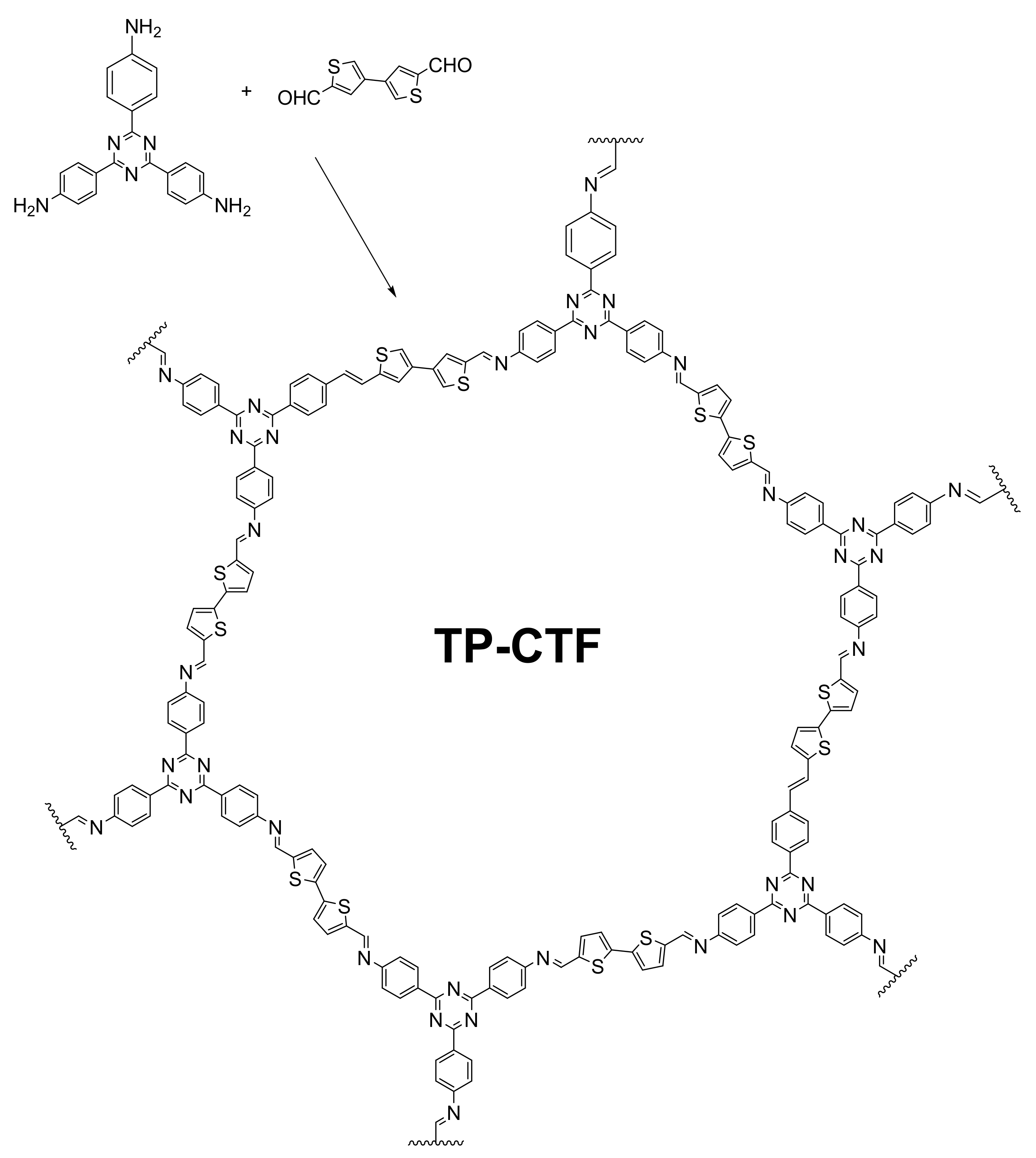
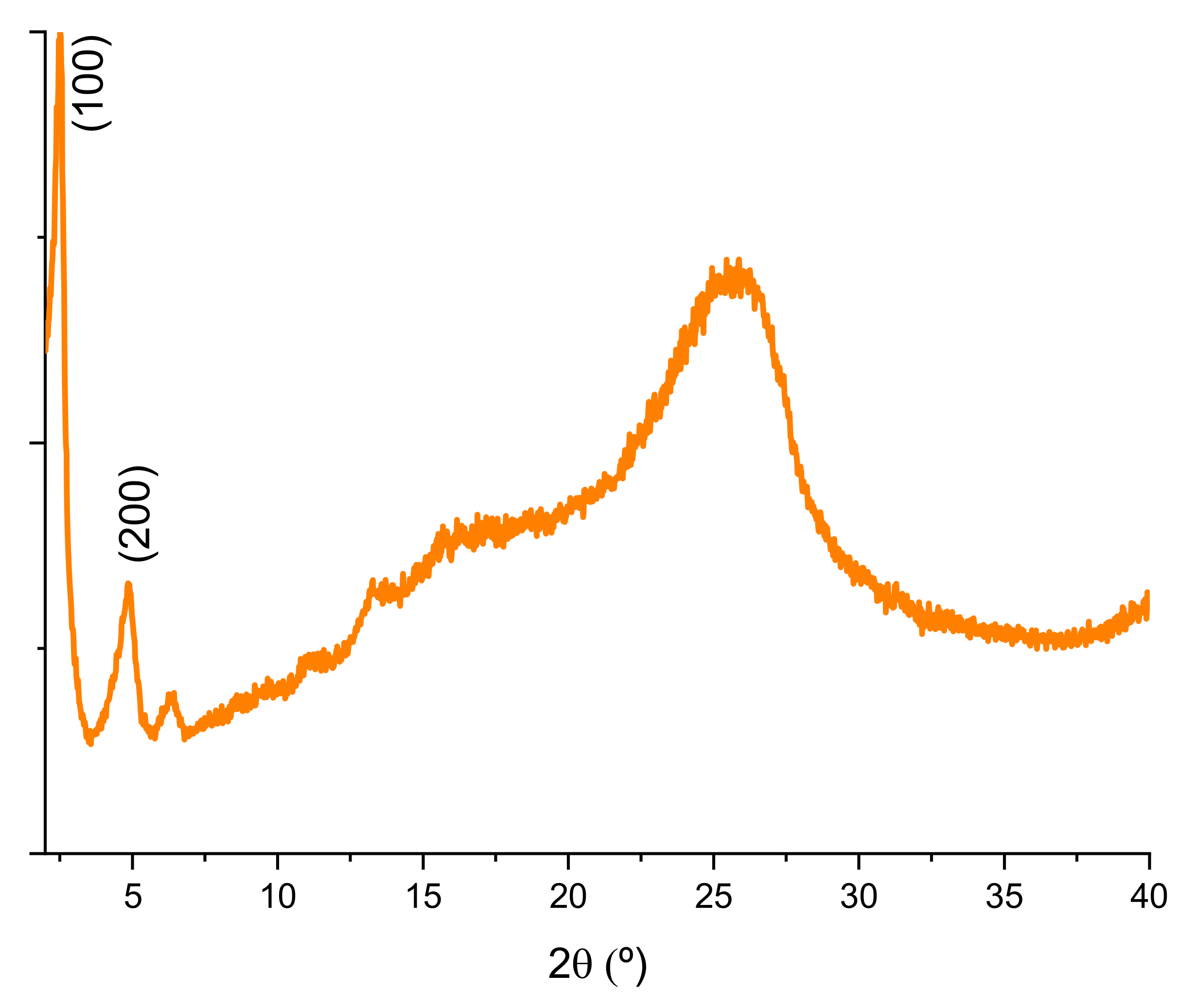
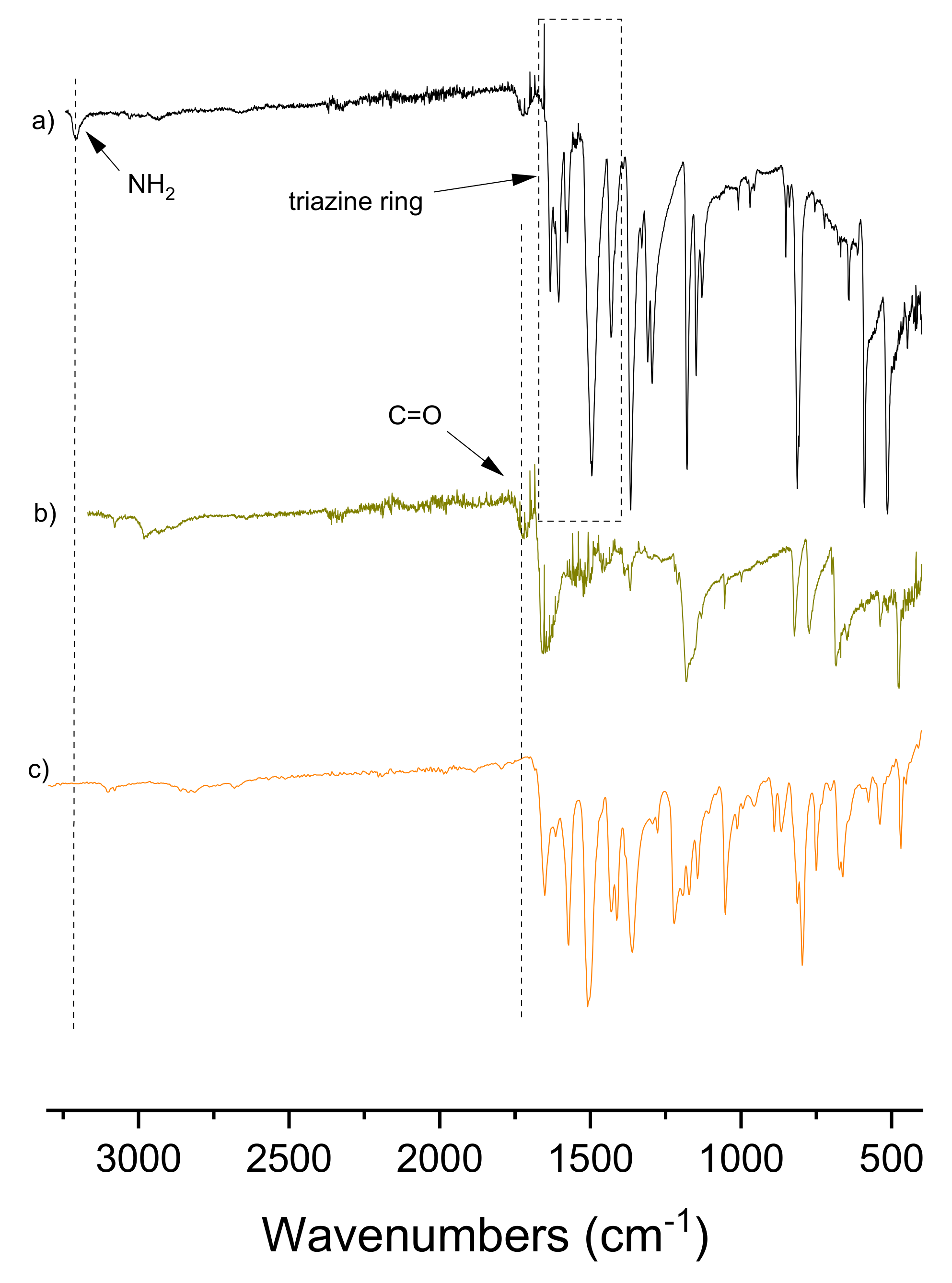

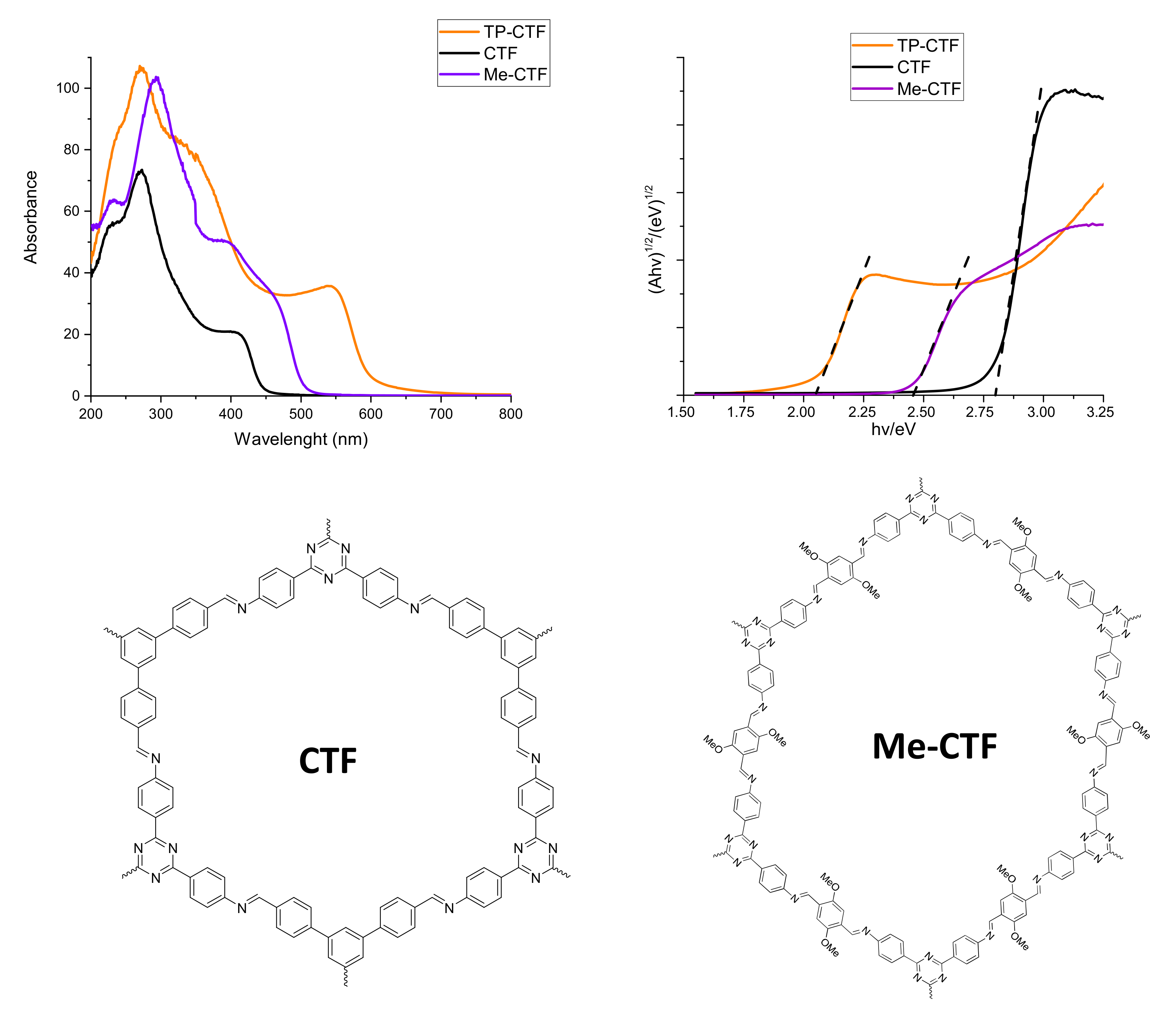


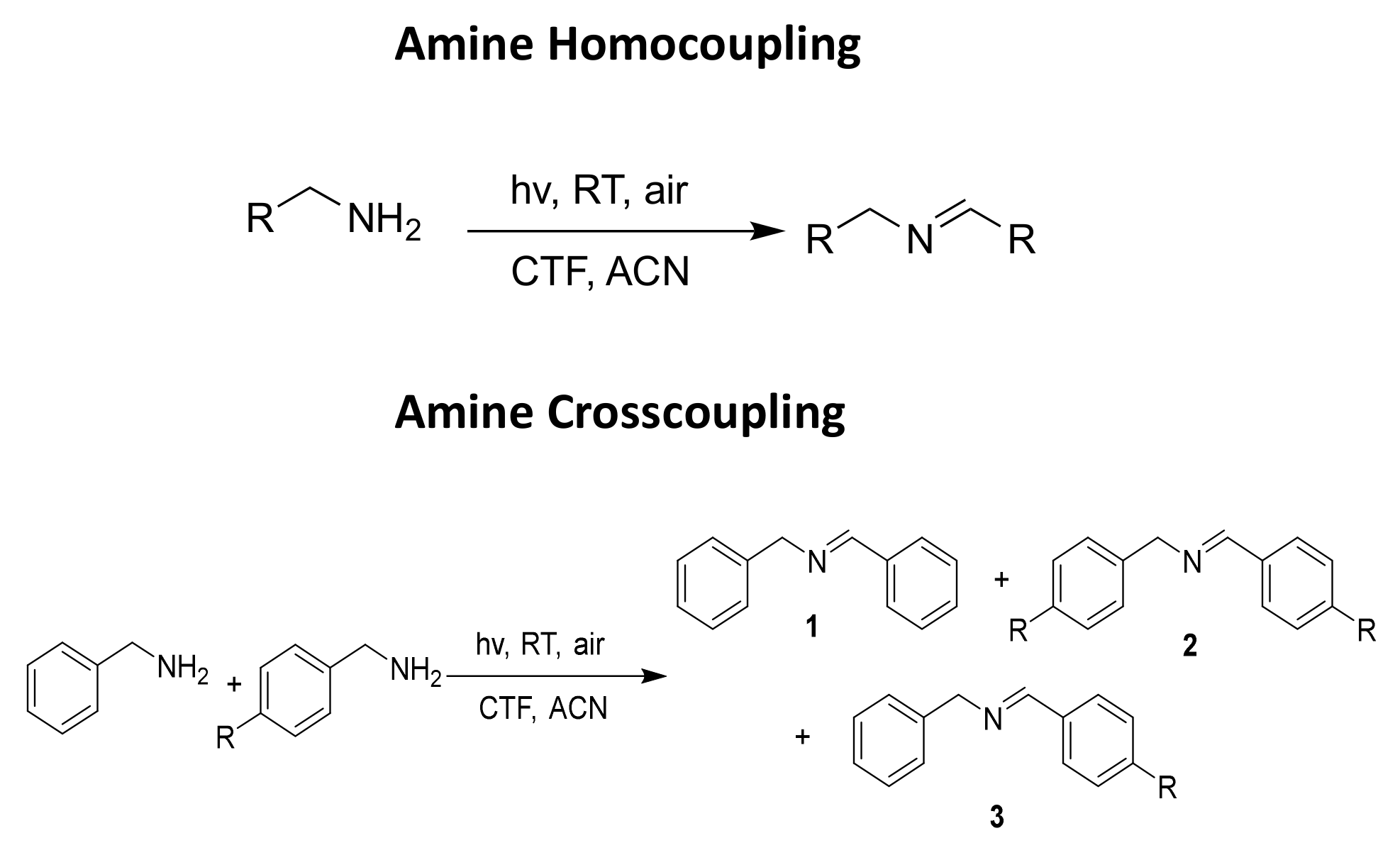
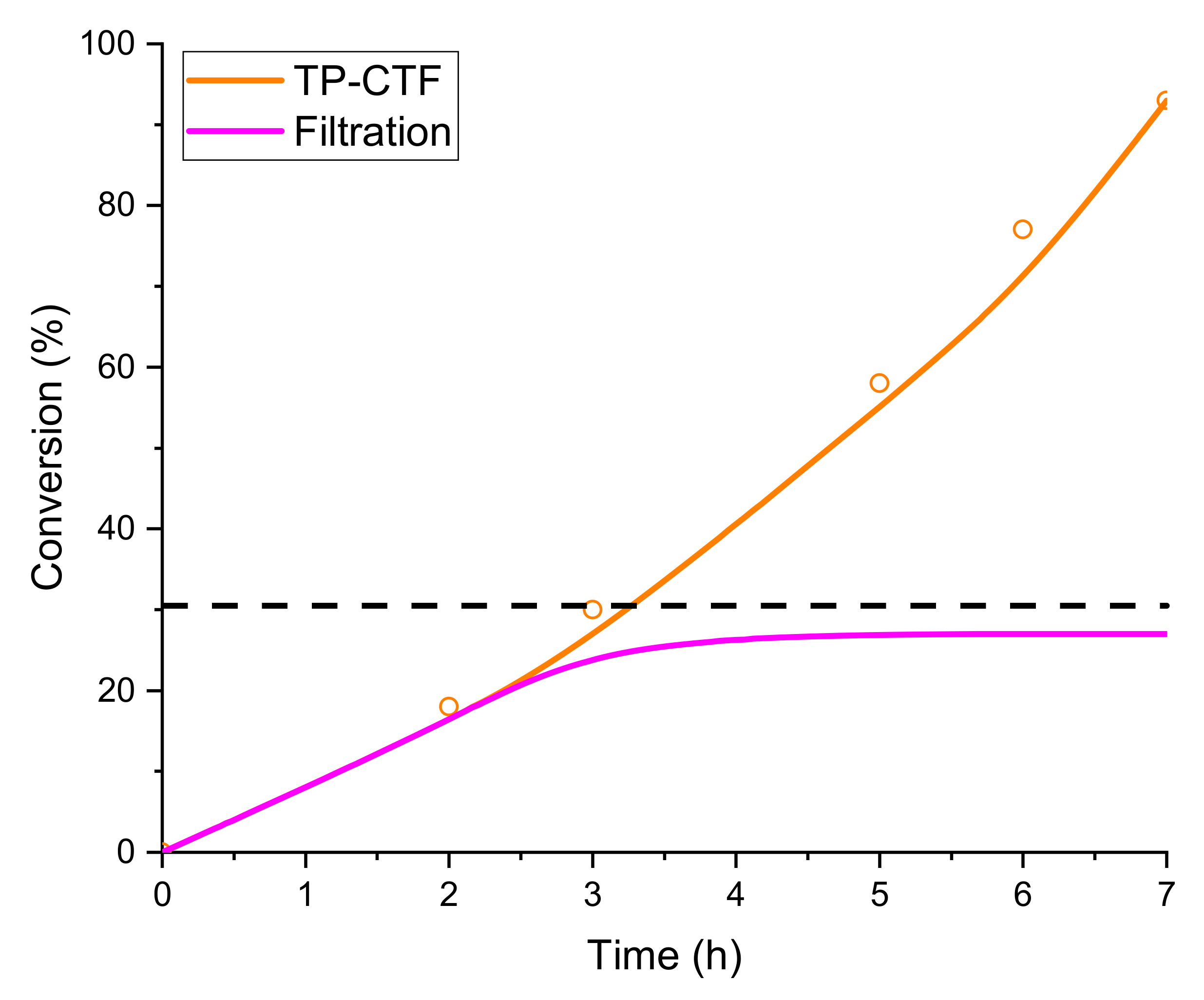
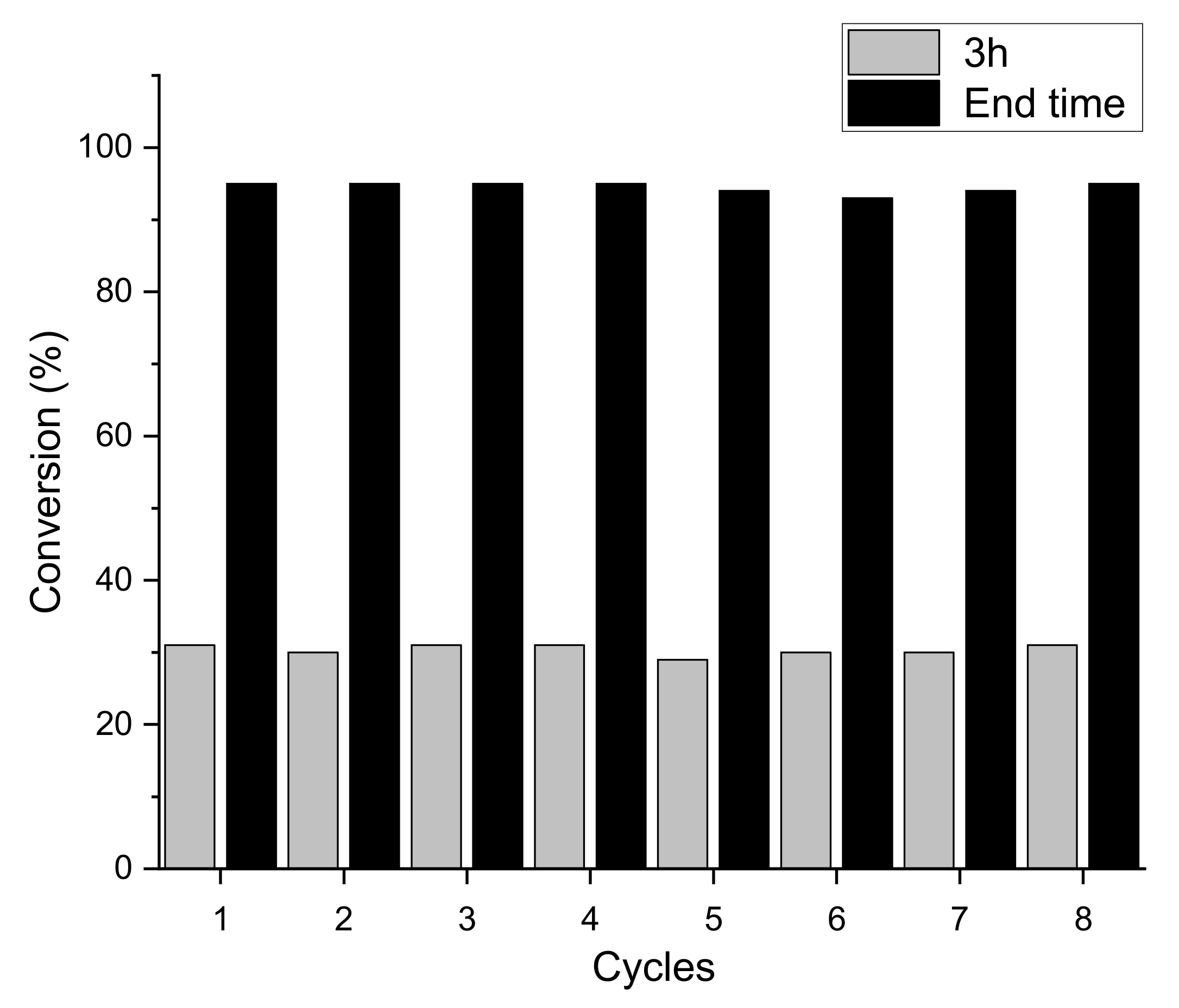
| Entry | Catalyst | Substrate | Product | Conv (%) | Select (%) |
|---|---|---|---|---|---|
| 1 | Blank |  |  | 0 | 0 |
| 2 | TP-CTF | 100 | 100 | ||
| 3 | TP-CTF b | 0 | 0 | ||
| 4 | CTF | 52 | 100 | ||
| 5 | Me-CTF | 30 | 100 | ||
| 6 | TP-CTF |  |  | 100 | 100 |
| 7 | TP-CTF |  |  | 100 | 100 |
| 8 | TP-CTF |   |  | 100 | 59 |
Disclaimer/Publisher’s Note: The statements, opinions and data contained in all publications are solely those of the individual author(s) and contributor(s) and not of MDPI and/or the editor(s). MDPI and/or the editor(s) disclaim responsibility for any injury to people or property resulting from any ideas, methods, instructions or products referred to in the content. |
© 2024 by the authors. Licensee MDPI, Basel, Switzerland. This article is an open access article distributed under the terms and conditions of the Creative Commons Attribution (CC BY) license (https://creativecommons.org/licenses/by/4.0/).
Share and Cite
Melero, M.; Díaz, U.; Llabrés i Xamena, F.X. Thiophene-Based Covalent Triazine Frameworks as Visible-Light-Driven Heterogeneous Photocatalysts for the Oxidative Coupling of Amines. Molecules 2024, 29, 1637. https://doi.org/10.3390/molecules29071637
Melero M, Díaz U, Llabrés i Xamena FX. Thiophene-Based Covalent Triazine Frameworks as Visible-Light-Driven Heterogeneous Photocatalysts for the Oxidative Coupling of Amines. Molecules. 2024; 29(7):1637. https://doi.org/10.3390/molecules29071637
Chicago/Turabian StyleMelero, Manuel, Urbano Díaz, and Francesc X. Llabrés i Xamena. 2024. "Thiophene-Based Covalent Triazine Frameworks as Visible-Light-Driven Heterogeneous Photocatalysts for the Oxidative Coupling of Amines" Molecules 29, no. 7: 1637. https://doi.org/10.3390/molecules29071637
APA StyleMelero, M., Díaz, U., & Llabrés i Xamena, F. X. (2024). Thiophene-Based Covalent Triazine Frameworks as Visible-Light-Driven Heterogeneous Photocatalysts for the Oxidative Coupling of Amines. Molecules, 29(7), 1637. https://doi.org/10.3390/molecules29071637









